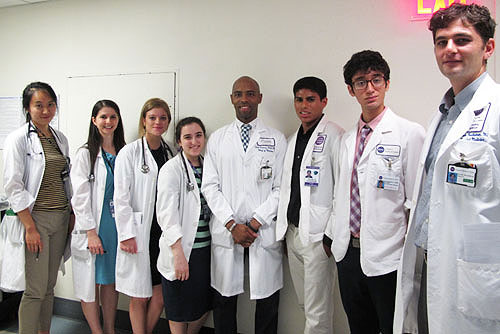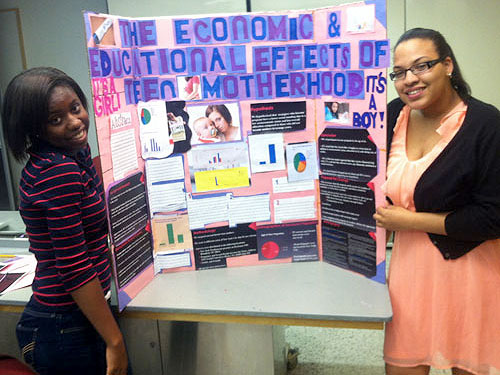| Return
to STEP In the News
High School Fellows
Program Gives Students a Chance to STEP into Careers in Medicine
and Science
August 15, 2013 @ NYU Langone Medical
Center (NYULMC)

The 2013 class of High School Fellows on a visit to the Neuroscience
Institute.
On the morning of Monday July 29, the “Red Team”
was huddled around a small conference table at Tisch 17 East,
hashing out a complex case. A 56-year-old woman with a history
of endometriosis and several abdominal surgeries was experiencing
acute pain. Was it being caused by an infection from a prior
surgery, a new obstruction, or was the source neurological?
Little by little, the team worked to tease apart the web of
factors that could be contributing, and drill down to the
most likely source of her current complaint. “Let’s
try to put the pieces together, and build a history in terms
of what might have happened to her,” said Fritz Francois,
MD, Tisch Hospital chief of medicine, who had joined attending
physician Benjamin Wertheimer, MD, a hospitalist and medical
director of 17 East, on rounds that day.
The team itself was led by a resident, and also included interns
and a medical student. But that Monday, there were two additional
members, complete with white coats, following along and even
occasionally joining in the discussion, for instance, when
Dr. Francois asked the group to explain what a fistula is.
(It’s a connective tissue that develops between two
organs or tissues that are normally not attached.)
The two students joining the Red Team that morning weren’t
medical trainees—not yet, anyway. They were incoming
high school seniors Kenneth Rodriquez and Salvador Lopez,
part of the STEP High School Fellows Program. STEP stands
for Science and Technology Entry Program, an initiative sponsored
by the New York State Department of Education to give under-represented
students early exposure to science and medical careers. The
Medical Center has been participating in the program, as part
of a consortium with the Associated Medical Schools of New
York (AMSNY), in various incarnations since 1987.
“The STEP High School Fellows Program is really a landmark
in encouraging young people from diverse socioeconomic and
ethnic backgrounds to pursue careers in the medical professions,
whether it’s becoming a doctor, nurse, physical therapist,
technician, even optometry and dentistry,” says Carlos
Restrepo, who has served as director of the STEP-HSFP program
for 11 years, most recently under the direction of Mariano
Rey, MD, assistant professor and senior associate dean for
community health affairs, part of the Department of Population
Health, and Arnold Stern, MD, PhD, professor of pharmacology
and assistant dean for extramural educational programs. Restrepo
continued, “By giving kids first-hand exposure into
these professions—actually going into the hospital,
the clinic, the lab—they become viable career aspirations,
whereas otherwise they might feel out of reach for some of
these students.”

The 'Red Team' during rounds at
Tisch 17 East, from left: Trainees Louisa Hong, MD;
Iula
Guiroiu, MD; Alison Young, MD; and medical student Leah
Traube; Tisch Hospital chief of
medicine Fritz Francois, MD; High School Fellows Kenneth
Rodriguez and Salvador Lopez;
and Benjamin Wertheimer, MD, medical director of 17
East. |
His sentiments were echoed by Kenneth, based on his experiences
this summer. When asked what surprised him most, he responded,
“How actually in touch you are with the patients. You’re
by their bedside, you’re with the doctors. It does give
you a sense that this is a realistic goal.”
The 'Red Team' during rounds at Tisch 17 East, from left:
Trainees Louisa Hong, MD; Iula
Guiroiu, MD; Alison Young, MD; and medical student Leah Traube;
Tisch Hospital chief of
medicine Fritz Francois, MD; High School Fellows Kenneth Rodriguez
and Salvador Lopez;
and Benjamin Wertheimer, MD, medical director of 17 East.
Kenneth, who is 16, will be a senior at Brooklyn Tech in the
fall. He was encouraged to apply to NYULMC’s program
by his older sister, who had been a fellow three years ago
and had an altogether different experience from his. “At
first she wanted to go into medicine,” Kenneth said,
“and she did this program, and she realized that it
was not for her. She couldn’t even stand the sight of
blood! I told her I was thinking about medicine, and she said
‘You have to do this program, just to make sure you
really are interested.’” His answer, after five
weeks? “Yes, definitely!”
That excitement is common among the High School Fellows. Dr.
Wertheimer said, “When I told Kenneth and Salvador that
I would arrange for them to observe a patient undergo a cardiac
catheterization, they literally high-fived each other out
of excitement. It is exactly that type of enthusiasm I hope
that they take from this experience. I hope that they realize
that their passion to become a doctor is real and that they
should be more excited than ever about the opportunities ahead.”
STEP is actually a year-long program that begins in the spring
of students’ junior years, with preparation for the
college application process that includes SAT prep as well
as beginning to look at schools. The six-week summer portion
includes preceptorships, in which the students generally spend
two mornings a week for four weeks “shadowing”
various professionals around the Medical Center. Kenneth spent
time with an orthopaedic surgeon, a neurologist who specializes
in multiple sclerosis, and an oncologist, while Salvador visited
a lab studying cholesterol at Bellevue and a radiologist.

High School Fellows Alexa Aarons
(left) and Tiffany Gonzalez with their final project
poster. |
“I think it is hugely important to listen to young
peoples' interests and to cultivate them; to hear the things
that they are excited and passionate about and then to provide
them opportunities to explore, develop and grow these interests,”
said Dr. Wertheimer of his choice to participate in the program.
“It was a great pleasure to show students the area of
medicine I practice—to take them to the bedside to meet
patients, to discuss the complexities of medical issues and
decisions, to let them come on rounds to feel what it is like
to be part of the medical team and to allow them to ask questions
about what they saw and what it means to do medical work.”
High School Fellows Alexa Aarons (left) and Tiffany Gonzalez
with their final project poster.
In addition to the preceptorships, the summer session also
includes final projects that focus on public health, culminating
in a poster presentation session held this year on August
8. Students go into the field in their communities to gauge
public perceptions and awareness on a variety of health issues.
In Kenneth and Salvador’s case, their four-member group
focused on body image and how it may be influenced by socio-economic
status and ethnicity. Other groups concentrated on substance
abuse, teen pregnancy, diabetes, and bullying, to name a few
examples.
When they are not shadowing doctors or working on their projects,
the fellows also attend college fairs and visit related institutions,
including the Washington Square campus, the schools of nursing
and dentistry, and the SIM Center. It’s all part of
giving students a leg up in choosing what path to pursue.
In the fall, they will be paired with medical students who
will provide support and mentorship in the college application
process as well as giving insight into their chosen field.
While inevitably some STEP alums take up other pursuits—Restrepo
mentions two who are currently in Teach for America—others
go on to careers in healthcare. One former fellow is about
to start NYU’s accelerated nursing program this fall,
after already having earned her MPH. Another is in medical
school at Temple University in Philadelphia, after doing research
at Mount Sinai.
Whatever they chose to do, the High School Fellows program
gives students a view of the medical profession they would
likely never have through any other avenue at their age. After
the Red Team had spent about half an hour retracing their
patient’s case, they headed to the bedside, observing
as Dr. Francois obtained a detailed medical history from her
and examined what emerged as the most likely source of her
pain—an ostomy in her abdomen.
Afterwards, Dr. Wertheimer shared a well-articulated and invaluable
lesson about the practice of medicine. “I would just
advocate in general that everything we do in medicine carries
with it a risk of side-effects and complications,” he
told the team. “Everything that has happened to her
recently, has been a side effect or complication of medical
treatment . . . . Being a great doctor doesn’t just
mean doing more. It means knowing when to step back and show
restraint and give things time to settle.”
When asked what about his experience has solidified his interest
in becoming a doctor, Kenneth said, “Seeing the humility
of the doctors with patient care, interacting one-on-one and
understanding the patients, and trying to actually treat them.
It’s a puzzle, really. You’re trying to solve
it to help the patient.”
Source: New York University School of Medicine:
Life at NYULMC
|

